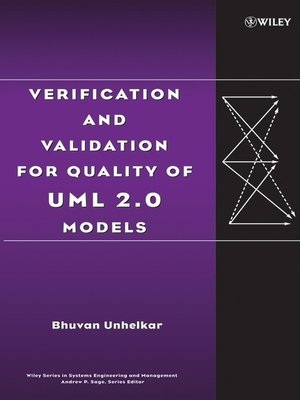Verification and Validation for Quality of UML 2.0 Models
ebook ∣ Wiley in Systems Engineering and Management
By Bhuvan Unhelkar

Sign up to save your library
With an OverDrive account, you can save your favorite libraries for at-a-glance information about availability. Find out more about OverDrive accounts.
Find this title in Libby, the library reading app by OverDrive.



Search for a digital library with this title
Title found at these libraries:
| Library Name | Distance |
|---|---|
| Loading... |
A practical approach to enhancing quality in software models using UML Version 2.0
"Despite its increasing usage, many companies are not taking the best advantage of UML and, occasionally, individuals have experienced frustration in applying its standards. Perhaps this is because they have not yet read this book!"
-From the Foreword by Prof. Brian Henderson-Sellers
This book presents a practical checklist approach to enhancing the quality of software models created with the Unified Modeling Language (UML) Version 2.0. The foundation for quality is set by the discussion on the nature and creation of UML models. This is followed by a demonstration of how to apply verification and validation checks to these models with three foci: syntactical correctness, semantic meaningfulness, and aesthetic symmetry. The quality work is carried out within three distinct yet related modeling spaces:
* Model of problem space (MOPS)
* Model of solution space (MOSS)
* Model of background space (MOBS)
Readers can then choose a specific quality approach according to their roles in their projects.
Verification and validation checks are also organized according to these three modeling spaces, making it easier for the reader to focus on the appropriate diagrams and quality checks corresponding to their modeling space. In addition, a major element of this publication is the Strengths, Weaknesses, Objectives, and Traps (SWOT) analysis. This analysis is performed on each UML diagram, enabling readers to fully comprehend these diagrams, their advantages and limitations, and the way in which they can be used in practical projects for modeling.
A consistent case study of the Lucky Insurance System is provided throughout the chapters to illustrate the creation of good quality UML diagrams, followed by application of quality checks to them. With its emphasis on quality in UML-based projects, this book is an essential resource for all quality professionals, including quality analysts, process consultants, quality managers, test designers, and testers.
"Despite its increasing usage, many companies are not taking the best advantage of UML and, occasionally, individuals have experienced frustration in applying its standards. Perhaps this is because they have not yet read this book!"
-From the Foreword by Prof. Brian Henderson-Sellers
This book presents a practical checklist approach to enhancing the quality of software models created with the Unified Modeling Language (UML) Version 2.0. The foundation for quality is set by the discussion on the nature and creation of UML models. This is followed by a demonstration of how to apply verification and validation checks to these models with three foci: syntactical correctness, semantic meaningfulness, and aesthetic symmetry. The quality work is carried out within three distinct yet related modeling spaces:
* Model of problem space (MOPS)
* Model of solution space (MOSS)
* Model of background space (MOBS)
Readers can then choose a specific quality approach according to their roles in their projects.
Verification and validation checks are also organized according to these three modeling spaces, making it easier for the reader to focus on the appropriate diagrams and quality checks corresponding to their modeling space. In addition, a major element of this publication is the Strengths, Weaknesses, Objectives, and Traps (SWOT) analysis. This analysis is performed on each UML diagram, enabling readers to fully comprehend these diagrams, their advantages and limitations, and the way in which they can be used in practical projects for modeling.
A consistent case study of the Lucky Insurance System is provided throughout the chapters to illustrate the creation of good quality UML diagrams, followed by application of quality checks to them. With its emphasis on quality in UML-based projects, this book is an essential resource for all quality professionals, including quality analysts, process consultants, quality managers, test designers, and testers.







